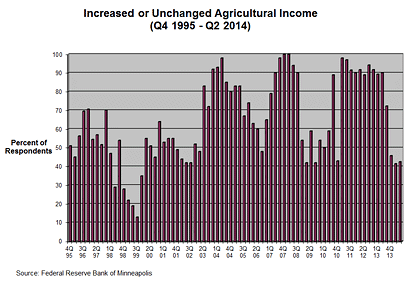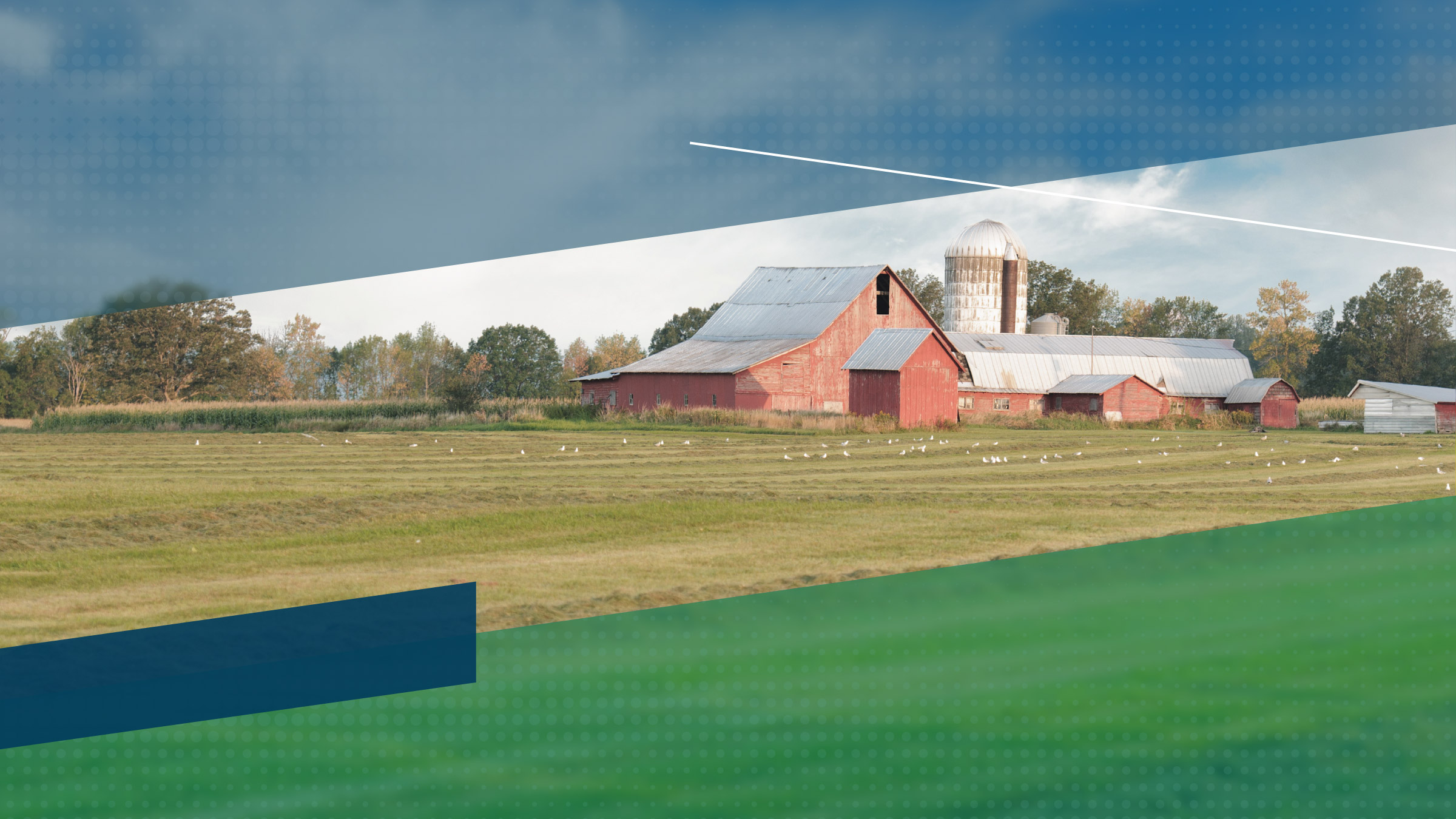“Crops look great, even with late planting,” wrote a Minnesota banker, reflecting a sentiment heard broadly across the Ninth District. But, the lender cautioned, “prices for this fall and beyond do not look good. The cash flows will be very tight!”
Farm incomes fell from April through June, according to results of the Minneapolis Fed’s second-quarter (July) agricultural credit conditions survey. Capital spending decreased, while household spending held roughly steady, lenders responding to the survey indicated. Falling incomes pushed the rate of loan repayment down slightly, while renewals and extensions increased, though most lenders reported that both were flat. Respondents noted further signs that cropland values were moderating, with prices falling in some areas, though the volume of land sales appears to have decreased. The third-quarter outlook is for continued contraction, with survey respondents predicting further decreases in income, capital expenditure and household spending.
Farm income, household spending and capital investment
More than half of district lenders responding to the survey (58 percent) reported that farm incomes decreased in the second quarter of 2014 from the previous quarter, while 14 percent said that incomes increased (see chart). Household spending within the district was flat, with nearly two-thirds of lenders reporting no change, while more noted decreases than increases. Capital spending was also down, with 48 percent of lenders saying it decreased compared with 12 percent claiming it increased.
Likely due to strength in ranching, Montana had a lower percentage of lenders reporting decreased income than other district states; Minnesota had the highest rate at 73 percent. Capital spending was flat in Montana, but down elsewhere. This was reflected in several survey comments, including one Minnesota contact who said, “Most of our farmers are going to delay their capital purchases until they know their crops will be sufficient.” Reports of flat household spending were largely consistent across district states, though higher proportions of lenders in South Dakota reported it increases, while more lenders in Wisconsin noted decreases.
Loan repayments and renewals
In keeping with results from recent quarters, most respondents indicated that the loan repayment rates and renewals were holding steady. However, more agricultural bankers in the district are now seeing reduced repayment rates than in the first quarter. Loan repayments were unchanged for 70 percent of respondents, while 20 percent reported lower rates. A bigger majority of lenders, 80 percent, stated that the number of renewals has held steady, and 16 percent reported greater renewal activity.
Demand for loans, required collateral and interest rates
As might be expected during a time of lower farm incomes, demand for agricultural loans rose substantially from the last survey. The fraction of lenders reporting increased loan demand rose to 43 percent in the second quarter from 25 percent in the first; 40 percent experienced no change. A few respondents noted that the amount of required collateral increased, but 92 percent reported no change. Interest rates were little changed: Fixed rates on operating loans rose slightly on average from the previous quarter, while fixed rates barely changed for machinery or real estate loans. Variable rates fell a small amount on loans for machinery and real estate, but were nearly unchanged for operating loans.
Cash rents and land values
Recent quarterly surveys have indicated that land prices have moderated following a multiyear period of strong growth, and the second-quarter results continue this trend; values decreased in some cases, along with cash rents. The average value for nonirrigated cropland in the district fell by almost 2 percent from a year earlier, according to survey respondents. Irrigated land fell slightly more (between 2 percent and 3 percent), while ranchland values increased 4 percent, likely owing to strong livestock and dairy prices. The district average cash rent for nonirrigated land fell 6 percent from a year ago, more than the decrease in value. Rents for irrigated land decreased 4 percent, while ranchland rents, which had continued growing in recent quarters, fell by nearly 2 percent.
However, the picture was mixed across the district. Values fell most in Minnesota and Wisconsin, where lenders reported that nonirrigated cropland prices dropped 4 percent and 6 percent, respectively, compared with a year earlier. Rents for the same land fell 9 percent in Minnesota, but were unchanged in Wisconsin. Meanwhile, price appreciation continued in North Dakota, which saw nonirrigated land up 8 percent and ranchland up a whopping 26 percent. The Bakken oil boom is likely playing a role, as a banker in western North Dakota noted that “land sales are all for commercial development.” Declines in cash rents were seen more broadly in the region; even in North Dakota, nonirrigated land rents were down 4 percent and ranchland rents were up only slightly.
Land sales volumes down
The second-quarter survey asked lenders a special question on farmland sales volumes, and it appears there are fewer land sales than last year. A slight majority (54 percent) indicated that the number of sales had decreased from a year earlier, while an additional third of respondents reported no change in volumes. “Land sales have slowed, but [the] price is constant with maybe a little softening,” commented a South Dakota banker.
Outlook
Not surprisingly, expectations are slightly pessimistic, on balance. Across the district, 52 percent of lenders predicted that farm income will decrease in the third quarter of 2014, compared with 12 percent forecasting increases. The outlook for household spending is more level, with 24 percent expecting decreases, while 42 expect capital spending to fall. Loan demand was generally forecast to rise in the upcoming quarter (34 percent expect increases), while the outlook for repayments, renewals and collateral requirements is mostly flat.
Though bankers around the district reported good crop conditions, flooding in some areas is taking a toll. “Weather will move the market,” wrote a South Dakota banker, who warned that we remain a “long ways from the bin.”
Percent of respondents who reported decreased levels for the past three months compared with the same period last year:
| MN |
MT |
ND |
SD |
WI |
Ninth District |
|
| Rate of loan repayments | 27 |
- |
16 |
19 |
25 |
20 |
| Net farm income | 73 |
20 |
53 |
52 |
62 |
57 |
| Farm household spending | 30 |
- |
16 |
15 |
38 |
21 |
| Farm capital spending | 65 |
10 |
47 |
44 |
25 |
48 |
| Loan demand | 19 |
20 |
16 |
22 |
- |
18 |
Percent of respondents who reported increased levels for the past three months compared with the same period last year:
| MN |
MT |
ND |
SD |
WI |
Ninth District |
|
| Loan renewals or extensions | 27 |
- |
22 |
- |
25 |
16 |
| Referrals to other lenders | - |
- |
- |
- |
- |
- |
| Amount of collateral required | 8 |
10 |
5 |
11 |
- |
8 |
| Loan demand | 43 |
20 |
53 |
44 |
38 |
43 |
Percent of respondents who expect decreased levels for the next three months:
| MN |
MT |
ND |
SD |
WI | Ninth District |
|
|---|---|---|---|---|---|---|
| Rate of loan repayments | 26 |
- |
11 |
17 |
- |
18 |
| Net farm income | 62 |
10 |
53 |
63 |
25 |
52 |
| Farm household spending | 35 |
- |
21 |
22 |
13 |
24 |
| Farm capital spending | 62 |
- |
33 |
48 |
- |
42 |
| Loan demand | 21 |
- |
11 |
29 |
- |
17 |
Percent of respondents who expect increased levels for the next three months:
| MN |
MT |
ND |
SD |
WI | Ninth District |
|
|---|---|---|---|---|---|---|
| Loan renewals or extensions | 18 |
- |
22 |
4 |
14 | 13 |
| Referrals to other lenders | - |
- |
- |
- |
- |
- |
| Amount of collateral required | 9 |
- |
11 |
16 |
- |
10 |
| Loan demand | 32 |
- |
47 |
42 |
29 |
34 |
Note: The Upper Peninsula of Michigan is not part of the survey.
Appendices:
Joe Mahon is a Minneapolis Fed regional outreach director. Joe’s primary responsibilities involve tracking several sectors of the Ninth District economy, including agriculture, manufacturing, energy, and mining.






